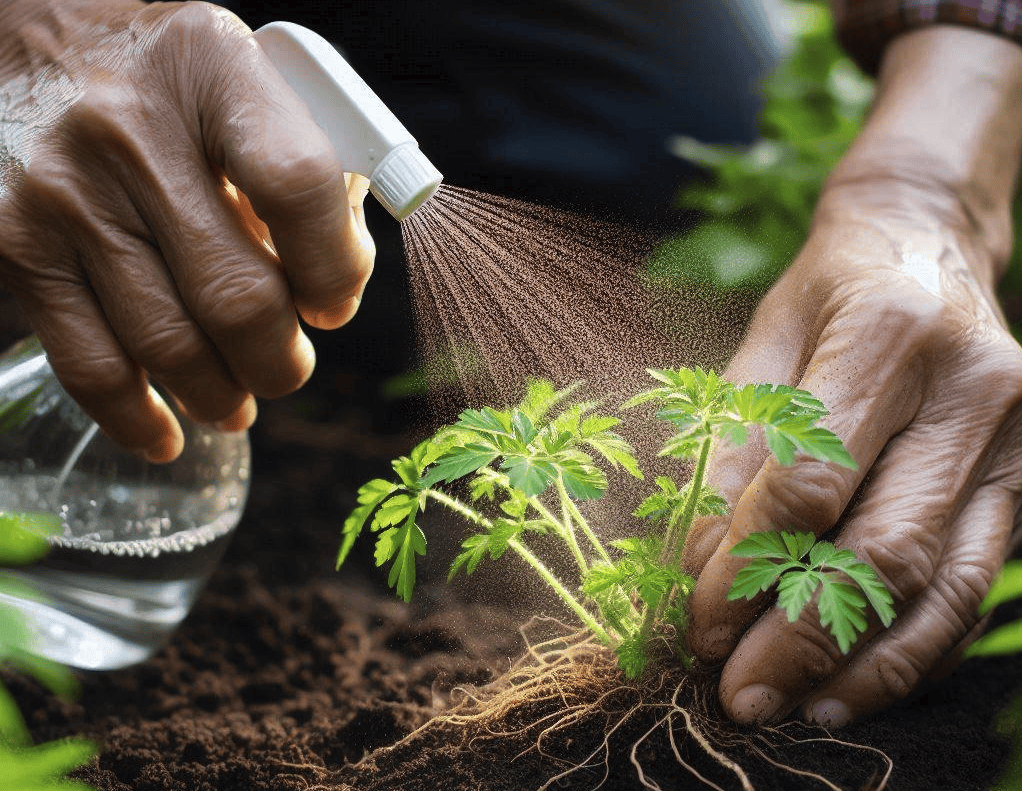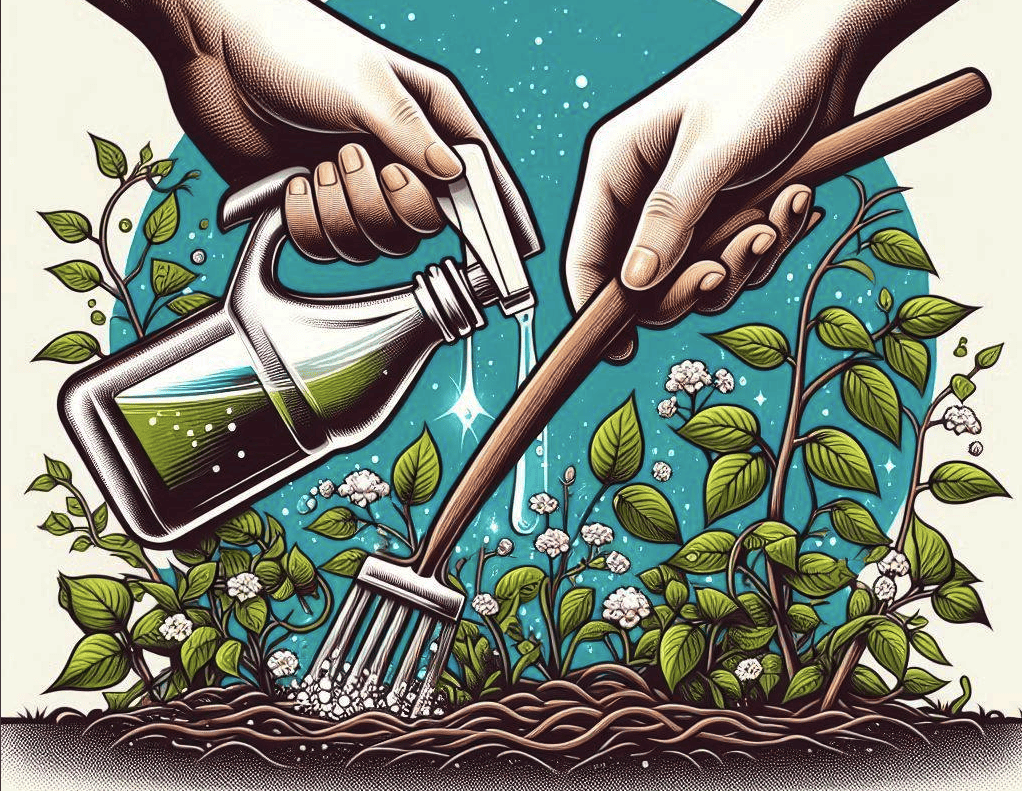As a homeowner passionate about maintaining a thriving garden, tackling the persistent issue of weeds can often feel like an ongoing battle. The sight of these unwanted intruders can be disheartening, affecting not only the aesthetics of your garden but also hindering the growth of your beloved plants. In your quest for a sustainable and effective solution, the natural remedy of using vinegar as a weed killer may just be the eco-friendly answer you’ve been seeking. In this guide, we will delve into the world of weed removal with vinegar, exploring its benefits, application methods, and tips for successful weed control. Let’s embark on this journey together to transform your garden into a weed-free sanctuary using the power of vinegar.
Understanding the Weed Problem
Weeds, often considered unwelcome guests in gardens, come in various forms, each with its unique characteristics. By recognizing these common types of weeds, you can better strategize your weed removal approach.
Types of Weeds:
Diving deeper into the world of weeds, it’s essential to identify the different types that may be lurking in your garden. The table below showcases some prevalent weed species along with their distinguishing features:
Weed Type |
Characteristics |
|---|---|
| Dandelion | Bright yellow flowers, deep taproot system |
| Crabgrass | Low-growing with spreading stems |
| Bindweed | Twining vine with heart-shaped leaves |
| Chickweed | Small white flowers, thrives in moist conditions |
| Purslane | Fleshy succulent leaves, often found in sunny spots |
Negative Impact of Weeds:
Weeds not only disrupt the visual harmony of your garden but also pose a myriad of challenges to the health of your plants. By fostering a better understanding of the negative impacts of weeds, you can appreciate the importance of proactive weed control measures.
- Dandelion: This stubborn weed with its deep taproot system competes with garden plants for essential nutrients and moisture, inhibiting their growth.
- Crabgrass: Its low-growing nature allows crabgrass to spread rapidly, forming dense mats that choke out desirable grass species.
- Bindweed: With its propensity to twine around plants, bindweed can distort their growth patterns and impede their access to sunlight.
- Chickweed: Thriving in damp environments, chickweed can carpet garden beds, reducing space and resources available for cultivated plants.
- Purslane: Identified by its fleshy succulent leaves, purslane can quickly colonize sunny areas, outcompeting delicate garden flora for space and nutrients.
Understanding the distinctive traits and negative impacts of these weed varieties is crucial in devising an effective weed management strategy tailored to your garden’s needs.

Vinegar as a Weed Killer
With the rise of eco-conscious gardening practices, vinegar has emerged as a natural and effective solution for combating weeds in a non-toxic manner. Understanding how vinegar works as a weed killer and the different types of vinegar available is key to harnessing its full potential in maintaining a weed-free garden.
How Vinegar Works:
Vinegar, specifically acetic acid, acts as a desiccant when applied to weeds, drawing out moisture and nutrients from the plant tissues, ultimately leading to their demise. This natural mechanism of action makes vinegar a safe and environmentally friendly alternative to chemical herbicides. By grasping the science behind vinegar’s weed-killing properties, you can harness its power efficiently to target unwanted vegetation in your garden.
Types of Vinegar:
When it comes to selecting vinegar for weed control, various types are available, each with its own acetic acid concentration levels. The table below outlines different vinegar options and their acetic acid content, aiding you in choosing the most suitable vinegar for your weed removal needs:
Vinegar Type |
Acetic Acid Content |
|---|---|
| Distilled Vinegar | 5-8% |
| White Vinegar | 5-20% |
| Apple Cider Vinegar | 5-6% |
| Rice Vinegar | 4-5% |
| Red Wine Vinegar | 5-6% |
By understanding the varying strengths of different vinegar types, you can make an informed decision on the most effective vinegar solution for targeting and eliminating weeds in your garden. Embrace the natural power of vinegar as a weed killer and witness the transformative impact it can have on maintaining a vibrant and weed-free garden space.
Preparation and Safety Measures
Before embarking on the journey of using vinegar as a weed killer, it is crucial to prioritize safety and proper preparation. Equipping yourself with the necessary safety precautions and understanding the correct dilution methods will ensure effective weed removal while safeguarding both your garden and well-being.
Safety Precautions:
Prior to applying vinegar as a weed control measure, it is essential to adhere to specific safety guidelines to protect yourself and the environment. Here are some key safety precautions to consider:
- Wear protective gear: Utilize gloves, goggles, and a mask to shield yourself from direct contact with vinegar, especially when handling concentrated solutions. Protecting your skin, eyes, and respiratory system is paramount during the application process.
- Avoid spraying on windy days: Choose calm weather conditions to prevent drift and ensure targeted application of vinegar. Windy conditions can cause the vinegar solution to spread to unintended areas, potentially affecting desired plantings.
- Store vinegar properly: Store vinegar in a secure location away from children and pets to prevent accidental ingestion. Proper storage ensures that vinegar remains out of reach and maintains its effectiveness for weed removal.
Mixing Vinegar:
To maximize the efficiency of vinegar as a weed killer, proper dilution is crucial. Below are guidelines for diluting vinegar for optimal weed removal effectiveness:
- Standard Strength (5-6%): For general weed control, mix1 part vinegar with 1 part water. This balanced solution is effective for targeting common weeds without causing harm to surrounding plants.
- Stronger Solution (10-20%): When dealing with tougher or persistent weeds, consider a mixture of 2 parts vinegar to1 part water. This stronger solution provides a more potent treatment for stubborn weed varieties.
- Extra Strength Solution: In cases where undiluted vinegar is required for highly resilient weeds, apply vinegar directly or with minimal water dilution. Use caution with this concentrated solution to prevent unintended damage to desired vegetation.
By following these mixing recommendations and safety precautions, you can tailor the strength of the vinegar solution to target different weed varieties effectively. Embrace safe practices and meticulous preparation to harness the full potential of vinegar as a natural and eco-friendly weed removal solution, ensuring a healthy and flourishing garden environment.
Application Methods
When it comes to eradicating weeds using vinegar, employing the correct application methods is crucial for achieving optimal results without harming desired plants. Understanding the different techniques, such as spray application and soil drenching, will empower you to effectively target weeds while preserving the health of your garden.
Spray Application:
Utilizing a spray bottle to apply vinegar directly onto weeds is a targeted and efficient method for weed control. To ensure successful weed elimination through spray application, follow these guidelines:
- Direct Spray: Aim the nozzle of the spray bottle directly at the weed, ensuring thorough coverage of the foliage. Targeting the weed’s leaves and stems with the vinegar solution helps penetrate the plant and disrupt its growth.
- Avoid Oversaturation: While it’s essential to coat the weed with vinegar, avoid oversaturating the surrounding soil to prevent potential damage to nearby plants. Controlled application reduces the risk of unintended consequences on desirable vegetation.
- Repeat as Necessary: Some resilient weeds may require multiple applications of vinegar to fully eradicate them. Monitor the progress of weed removal and reapply the vinegar solution as needed for persistent weeds.
Soil Drenching:
For weed control in larger garden areas or to address underground weed roots, soil drenching with vinegar provides a thorough and systemic approach. Here’s how to effectively implement soil drenching:
- Even Distribution: Pour the vinegar solution directly onto the soil around the base of the weed, ensuring even distribution throughout the root zone. This method targets the weed’s root system, hindering its growth and preventing regrowth.
- Allow Absorption Time: Give the vinegar solution time to be absorbed by the soil and reach the weed’s roots. Patience and allowing for proper absorption increase the effectiveness of soil drenching in eliminating weeds from the root up.
- Monitor Progress: Regularly check the treated area for any signs of weed resurgence. Soil drenching is a comprehensive approach that may require less frequent applications compared to spray methods, but monitoring is essential to ensure long-term weed control.
Additional Tips for Application Methods:
Tip |
Description |
|---|---|
| Use Vinegar with Soap Mix | Enhance vinegar’s effectiveness by adding a small amount of liquid soap to the solution to help it stick to weeds. |
| Apply in the Morning | Apply vinegar to weeds in the morning on a sunny day for optimal results, as the sun can enhance vinegar’s weed-killing properties. |
| Consider Concentrated Solutions | For persistent weeds, consider using undiluted vinegar or higher concentration solutions for targeted applications. |
It is true that by adopting these application methods and techniques tailored to your specific weed removal needs, you can successfully leverage the power of vinegar as a natural and eco-friendly solution for maintaining a weed-free garden environment.
Tips for Effective Weed Removal
Ensuring successful weed removal with vinegar involves strategic timing of application and post-application care to prevent weed regrowth. By implementing these tips and guidelines, you can enhance the effectiveness of vinegar as a natural weed killer while maintaining a healthy garden environment.
Timing of Application:
The timing of vinegar application plays a crucial role in maximizing its weed-killing potential. Consider the following timing tips for effective weed removal:
- Early Growth Stage: Targeting weeds in their early growth stages increases the likelihood of successful eradication. Young weeds are more susceptible to vinegar treatment, making it easier to control their growth before they become established.
- Dry Weather Conditions: Applying vinegar on a dry, sunny day enhances its efficacy as the plant tissues are more receptive to the solution. Avoiding rainy or humid days ensures that the vinegar can penetrate the weeds effectively.
- Avoid Application Near Desired Plants: Be mindful of applying vinegar near desired plants as it can have phytotoxic effects on them. Maintain a safe distance between the vinegar solution and your garden plants to prevent unintended damage.
Post-Application Care:
After applying vinegar to remove weeds, implementing post-application care practices is essential to prevent weed regrowth and maintain a weed-free garden. Here are some key post-application care tips:
- Mulching: Apply mulch around garden beds after weed removal to suppress weed growth and retain soil moisture. Mulch acts as a natural barrier, inhibiting weed seeds from germinating and establishing.
- Regular Inspection: Regularly inspect your garden for any signs of weed regrowth. Promptly address any emerging weeds by spot-treating them with vinegar to prevent their spread and maintain a weed-free environment.
- Promote Plant Health: Ensuring the health and vigor of your desired plants through proper watering, fertilization, and maintenance practices can help create a competitive environment that discourages weed growth.
Additional Recommendations for Weed Control:
Recommendation |
Description |
|---|---|
| Rotate Vinegar Applications | Rotate application areas to prevent weed resistance and address different weed populations effectively. |
| Combine Vinegar with Salt | Utilize a mixture of vinegar and salt for particularly stubborn weeds, as salt can act as a desiccant to enhance weed removal. |
| Consider Reapplication Intervals | Determine the frequency of vinegar reapplications based on weed regrowth patterns and adjust as needed for consistent control. |
If you incorporate these tips and recommendations into your weed removal strategy, you can harness the full potential of vinegar as a natural and eco-friendly solution. And maintaining a weed-free garden environment with minimal impact on surrounding plant life.

Comparing Vinegar to Traditional Weed Killers
Evaluating the efficacy and environmental impact of vinegar as a weed killer in comparison to traditional chemical herbicides provides insight into the benefits of adopting natural alternatives. Understanding the differences between vinegar and synthetic weed killers can help you make an informed decision that aligns with your gardening philosophy and sustainability goals.
Eco-Friendly Benefits:
One of the primary advantages of using vinegar for weed control is its eco-friendly nature compared to conventional herbicides. Vinegar is biodegradable, non-toxic to humans and pets, and does not leave harmful residues in the soil. In contrast, many chemical herbicides contain synthetic compounds that can persist in the environment, posing risks to biodiversity and water quality. By choosing vinegar as a natural weed killer, you contribute to a healthier ecosystem and reduce the overall environmental impact of weed management practices.
Effectiveness:
While vinegar is lauded for its eco-friendly properties, questions arise regarding its effectiveness compared to traditional weed killers. Vinegar’s efficacy in weed control is influenced by factors such as acetic acid concentration, application timing, and weed species targeted.
In general, vinegar is effective against many common weed varieties, especially when applied correctly and consistently. However, some persistent weeds may require multiple applications or higher concentration solutions for complete eradication.
Understanding the nuances of vinegar’s effectiveness in weed removal can help you tailor your approach for optimal results.

Advantages of Vinegar over Chemical Weed Killers:
Aspect |
Vinegar as Weed Killer |
Chemical Herbicides |
|---|---|---|
| Environmental Impact | Biodegradable and non-toxic | Synthetic compounds may harm ecosystem |
| Residual Effects | Leaves no harmful residues in soil | Residual chemicals can persist in the environment |
| Safety for Humans and Pets | Safe for humans and pets | Potential health hazards if ingested or inhaled |
By weighing the eco-friendly benefits, effectiveness, and safety aspects of vinegar against traditional chemical weed killers, you can make an informed choice that aligns with your values and promotes sustainable gardening practices.
To sum up
Weeds are a common frustration for gardeners, often detracting from the beauty and health of our beloved green spaces. However, there’s a simple, eco-friendly solution that many might overlook: vinegar. This natural substance offers a cost-effective, environmentally friendly alternative to traditional chemical weed killers, allowing you to maintain a beautiful garden without harming the ecosystem.
You can effectively integrate this method into your gardening routine by understanding the types of weeds you face and how vinegar works to combat them. Whether you choose to spray or drench, with the right preparation and timing, vinegar can become a powerful tool in your garden maintenance arsenal.

Michael Miller is a gardening enthusiast with a green thumb and a knack for fixing anything related to the world of plants. He envisions owning a vineyard in the future, a testament to his deep love for cultivation. Happily married with two kids in vibrant Tokyo, Japan, Michael’s life is a blend of botanical beauty and family bonds. Join him on his journey where gardening passion meets a vision for the future, and explore the secrets of cultivating a harmonious life.


